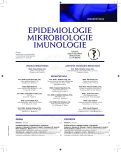Identification of Mycobacterium spp. isolates using matrix-assisted laser desorption/ionization-time-of-flight mass spectrometry (MALDI-TOF MS)
Authors:
J. Amlerová; V. Študentová; J. Hrabák
Authors‘ workplace:
Ústav mikrobiologie, Lékařská fakulta a Fakultní nemocnice v Plzni, Univerzita Karlova
Published in:
Epidemiol. Mikrobiol. Imunol. 63, 2014, č. 3, s. 195-198
Category:
Review articles, original papers, case report
Overview
Study objective:
Matrix-assisted laser desorption/ionization-time-of-flight mass spectrometry (MALDI-TOF MS) has recently been widely used in diagnostic microbiological laboratories. It is a cheap and rapid method for the identification of bacteria and micromycetes. Apart from this purpose, it is also used for the detection of antibiotic resistance mechanisms. It has the potential to be extended for other purposes in microbiology. The aim of this study was to validate MALDI-TOF MS for the identification of mycobacteria.
Material and methods:
Thirty isolates of Mycobacterium spp. isolated in the Laboratory of Mycobacteriology of the Plzeň University Hospital were included in the study. The isolates were identified to the species level using biochemical tests, gene probes, and sequencing of the gene encoding 16S rRNA. The identification by MALDI-TOF MS was performed with the use of silica beads. Strain identification by sequencing the gene encoding 16S rRNA was considered as the reference method.
Results:
MALDI-TOF MS correctly identified all isolates of Mycobacterium spp. (score range 1.461 – 2.168). The species identified were Mycobacterium tuberculosis (n= 5), Mycobacterium kansasii (n=5), Mycobacterium avium (n=6), Mycobacterium intracelullare (n=3), Mycobacterium xenopi (n=3), Mycobacterium gordonae (n=1), Mycobacterium abscessus (n=1), Mycobacterium kumamotonense (n=2), Mycobacterium mantenii (n=1), Mycobacterium lentiflavum (n=1), Mycobacterium fortuitum (n=1), and Mycobacterium scrofulaceum (n=1).
Conclusion:
MALDI-TOF MS is a suitable tool for the routine identification of Mycobacterium spp. in laboratories using this method for the conventional identification of microbes.
Keywords:
MALDI-TOF MS – Mycobacterium tuberculosis – 16S rRNA – sequencing
Sources
1. Ústav zdravotnických informací. Tuberkulóza a respirační nemoci 2012. Praha: ÚZIS, 2013. Available on: http://www.uzis.cz.
2. Tortoli E. Clinical manifestations of nontuberculous mycobacteria infections.Clin Microbiol Infect, 2009;15:906–910.
3. Drobniewski FA, Caws M, Gibson A, Young D. Modern laboratory diagnosis of tuberculosis. Lancet Infect Dis; 2003;3:141–147.
4. Slany M, Pavlik I. Molecular detection of nontuberculous mycobacteria: advantages and limits of a broad-range sequencing approach. J Mol Microbiol Biotechnol, 2012;22:268–276.
5. Seng P, et al. MALDI-TOF-mass spectrometry applications in clinical microbiology. Future Microbiol, 2010;5:1733–1754.
6. Shah HN, Gharbia SE. Mass Spectrometry for Microbial Proteomics, London: Wiley, 2010. ISBN 978-0-470-68199-2.
7. Hrabák J, Chudackova E, Walkova R. Matrix-Assisted Laser Desorption Ionization–Time of Flight (MALDI-TOF) Mass Spectrometry for Detection of Antibiotic Resistance Mechanisms: from Research to Routine Diagnosis. Clin Microb Rev, 2013;26:103–114.
8. Saleeb PG, Drake SK, Murray PR, Zelazny AM. Identification of Mycobacteria in Solid-Culture Media by Matrix-Assisted Laser Desorption Ionization–Time of Flight Mass Spectrometry. J Clin Microbiol, 2011;49:1790–1794.
9. Lotz A, et al. Rapid Identification of Mycobacterial Whole Cells in Solid and Liquid Culture Media by Matrix-Assisted Laser Desorption Ionization-Time of Flight Mass Spectrometry. J Clin Microbiol, 2010;48:4481–4486.
10. Marchesi JR, et al. Design and Evaluation of Useful Bacterium-Specific PCR Primers That Amplify Genes Coding for Bacterial 16S rRNA. Appl Environ Microbiol, 1997;64:795 – 799.
11. Havelková M, et al. Doporučené standardní metody v mikrobiologii mykobakteriálních infekcí. 1. vyd. Praha: SZÚ Praha ve spolupráci s firmou Trios s.r.o., 1998.
Labels
Hygiene and epidemiology Medical virology Clinical microbiologyArticle was published in
Epidemiology, Microbiology, Immunology

2014 Issue 3
Most read in this issue
- The current view of the diagnosis and management of amebiasis in the light of the authors’ own case reports
- Infections caused by human alpha herpes viruses
- Enterohemorrhagic Escherichia coli as the cause of diarrhea in the Czech Republic, 1965–2013
- Occurrence and characteristic of Staphylococcus aureus in pork meat
